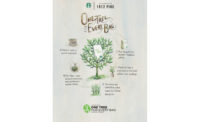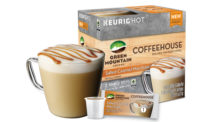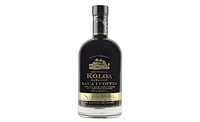For many Americans, the morning doesn’t start until their first sip of coffee. According to experts, the coffee category faces only a few unique trends impacting it. A recent Gallup study found that Americans are drinking just as much coffee now as they were in 1999, about 2.7 cups per day. “Sixty-four percent of U.S. adults report drinking at least one cup of coffee on an average day, unchanged from 2012 and remarkably similar to the figure in 1999,” Lydia Saad explained in her July report titled “Americans’ Coffee Consumption is Steady, Few Want to Cut Back.” “Additionally, coffee drinkers currently report consuming just under three cups of coffee per day, also unchanged.”
In the report, Saad notes that, specifically, 26 percent of American adults say they drink one cup of coffee on an average day, 19 percent drink two, 8 percent drink three and 11 percent drink four or more. The final 36 percent do not drink coffee, she adds.
“With research studies showing that moderate coffee consumption has no adverse health effects, and may even have some health benefits, it may be surprising that the proliferation of coffee shops throughout the country hasn’t hooked more people or caused current coffee drinkers to consume more,” Sadd explains. “It may be that people are sensitive to their body’s tolerance for caffeine and know when enough is enough, creating a natural barrier to consuming ever-increasing amounts. As a result, corner coffeehouses and advanced home-brewing machines may make drinking coffee more convenient — and even more pleasant — for people, but they are not stirring Americans to drink more.”
Although American’s might not be drinking more coffee every day, the market continues to grow. According to data from Information Resources Inc. (IRI), Chicago, dollar sales for Coffee and RTD Coffee reached $9.2 billion for the 52 weeks ending July 12 in U.S. supermarkets, drug stores, mass merchandisers, gas and convenience stores, military commissaries, and select club and dollar retail chains, a sales increase of 7.6 percent year-to-date.
“Total coffee volume in the U.S. grew by 1 percent in 2014 to reach 978 million kilograms consumed,” explains Eric Penicka, research analyst for Chicago-based Euromonitor International. “Growth in value terms was more notable, with off-trade value sales increasing by 4 percent to $12.8 billion, largely driven by coffee pods continued growth and increased preference for premium coffee.”
Although the category might not push consumers to drink more, it is pushing them to try new formats and varieties. “There have been some major brand and format launches in the U.S. in the last year, including the launch of McCafe in K-Cups and bagged coffee. This led to a lot of promotions in the category, particularly for the K-Cup format,” says Lauren Masotti, client manager for U.S. beverages for New York-based Kantar Worldpanel.
McDonald’s partnered with Northfield, Ill.-based Kraft Foods to market McCafe packaged coffee in grocery, mass merchandise, club and drug retail locations across the United States. McCafe packaged coffees are available in ground, whole bean and K-Cup formats and are made of a blend of 100 percent Arabica beans. It is available in varieties including Premium Roast, Breakfast Blend, French Roast, Colombian, Premium Roast Decaf, French Vanilla, Hazelnut and French Roast Whole Bean.
“The U.S. coffee market continues to grow,” Masotti continues. “This growth is seen in both hot and iced formats over the past few years — although hot formats account for the predominant share of the coffee market. Half of the population is drinking hot or iced coffee at least once in the average week.”
Euromonitor’s Penicka indicates that some of the growth this market has seen is due to increased prices largely from the growth of coffee pods and interest in premium coffees. “From Euromonitor’s perspective, coffee prices have been impacted much more by product mix than coffee bean trade prices,” he says. “Overall, the retail unit price of coffee rose by 4 percent, driven by coffee pods and fresh coffee beans. Coffee pods are capturing an increasing share of the coffee market and have considerably higher unit price than any other coffee type. Meanwhile, consumer migration to premium coffee beans is driving prices higher as well.”
Small size, big impact
It’s undeniable that single-cup coffee pods have impacted the coffee market in a major way. IRI data shows that single-cup coffee experienced sales increases of 19 percent reaching $3.5 billion dollars for the 52 weeks ending July 12 in U.S. multi-outlets.
“The convenience and simplicity [single-serve pods] offer has led to their continued growth, and they are the primary reason for growth in coffee in terms of value sales,” Penicka says.
“Coffee pods have been the driver of coffee growth in value terms,” Penicka adds. “The retail value growth (in constant, 2014 dollars) of coffee with pods removed exhibited a [compound annual growth rate] (CAGR) of 0 percent; however, when pods are included, coffee had a CAGR of 7 percent. Coffee pods now represent nearly one-third of retail coffee sales, despite having only 7 percent share of retail coffee as a whole.”
As the popularity of coffee pods continues to grow, more brands are launching their coffees in single-serve coffee pod formats. Farmer Bros. Co. recently launched its Metropolitan brand in coffee pod formats. The Metropolitan single cups are made with 100 percent Arabica beans. The new coffee pods are compatible with all Keurig 1.0 and 2.0 single-cup brewing systems and are available nationwide, the company says. The initial varieties of Farmer Brothers’ Metropolitan single cups include Breakfast Blend, 100% Colombia, Organic French Roast and Medium Roast Decaf.
“[Single-serve pods] are attracting more consumers, but K-Cup consumers tend to drink less coffee — consumers may have an extra cup when they brew a pot of coffee, but stop at one a day when it’s brewed from a K-Cup,” Kantar’s Masotti says. “As a result, volume is lighter, but value is higher as consumers pay more per cup.”
Chilly brew
One unique trend has been grabbing attention recently — cold-brew coffee. Experts note that this is a growing trend with consumers; however, it has not yet grown large enough to impact sales or further penetration.
“Cold brew, despite receiving a lot of attention in the press, remains very niche,” Euromonitor’s Penicka explains. “On-trade (foodservice) has been the backbone of this, and until recently, was reserved to independent specialty coffee shops. Peet’s Coffee and Starbucks’ adoption of cold brew could change this, however. Peet’s has entirely switched over to cold brew, discontinuing iced coffee, and Starbucks is offering cold-brew coffee for the first time this summer. This mainstream exposure has certainly thrown cold brew into the limelight on-trade; however, in the off-trade, things are less developed with really only HiBall Energy and Stumptown having something akin to a well distributed ready-to-drink coffee product, but even these are rather difficult to come across.”
In July, Starbucks Coffee Co. announced that its small-batch cold brew was being launched across the United States and Canada. “Cold Brew is the latest in a series of new coffee experiences at Starbucks that showcase the passion baristas have for coffee, and allows customers to learn more about the craft of roasting and brewing Starbucks beverages,” the company said in a statement.
The company says it steeps its Starbucks Cold Brew Blend coffee in cool water for 20 hours creating a concentrate that is topped with water and ice. “Cold Brew Blend features high-quality varietals from Latin America and Africa,” said Leslie Wolford, senior coffee specialist at Starbucks, in a statement. “The blend delivers a flavor profile of chocolate balanced by citrus notes for a sweet, dense and smooth cup.”
Kantar’s Masotti also notes the impact cold-brew coffee is having on consumers. “Younger consumers seem to be more engaged with formats like cold-brew, though it is still too small to really analyze the consumption base,” she says. “American consumers have always had a passion for the taste of coffee, and as iced coffee becomes more popular, it is reasonable to expect that great tasting brewing methods like cold-brew will become more popular.”
Grab-and-go
Although they’re not impacting the market as strongly as coffee pods, RTD coffees have continued to grow in popularity and variety as well.
According to IRI data, the iced coffee/cappuccino segment experienced sales increases of 17 percent year-to-date for $1.5 billion in the 52 weeks ending July 12 in U.S. supermarkets, drug stores, mass merchandisers, gas and convenience stores, military commissaries, and select club and dollar retail chains.
Experts say this is because frequency of purchases has grown in the segment. “Ready-to-drink coffees (iced, packaged in containers) boomed into the market in the past year or two, but still are a sub-segment of a niche category in the market,” Masotti explains. “Penetration has stabilized, but frequency has grown — the category attracted users and they really like drinking it. Outside of the retail element, cafés continue to grow, capturing the immediate consumption occasion out-of-the-home by fulfilling energy and treat needs throughout the day.”
Euromonitor’s Penicka agrees. “RTD coffee continues to have strong growth at 7 percent in volume terms in 2014,” he says. “The convenience of RTD coffee is very appealing to the on-the-go American consumer, who wants iced coffee without the coffee shop wait. Additionally, RTD coffee’s less bitter flavor profile has made it an appealing product for those who might not like the flavor of standalone coffee.”
Caffeine competition
Coffees could be experiencing some competition from coffee energy drinks. The energy drink market has experienced a similar amount of growth to that of the coffee market. Last month, Beverage Industry reported that the energy drink market experienced a 7.6 percent growth to approximately $11 billion for the 52 weeks ending June 14 in U.S. multi-outlets, according to IRI data.
“We see that consumers ‘self-regulate’ when it comes to caffeine consumption — as consumers add energy drinks they tend to reduce coffee consumption,” Kantar’s Masotti says.
Two brands have posed threats in particular, Monster’s Java line and Rockstar’s Roasted cappuccino line.
According to Penicka, one of the largest players in coffee-flavored energy drinks is Monster Java, which he says experienced double digit growth in 2014. According to IRI data, Java Monster’s dollar sales exceeded $300 million, a 14 percent increase year-to-date for the 52 weeks ending June 14 in U.S. multi-outlets.
Rockstar’s Roasted line, which includes Mocha, Caramel Macchiato, Almond Milk and White Chocolate, Caffe Latte and Light vanilla, reached
$7.9 million in sales for the 52 weeks ending July 12 in U.S. multi-outlets, according to IRI data.
Both product lines are advertised as being a mix of coffee and energy.
“Consumer perception of these products is that they are more natural, and therefore, healthy,” Penicka says.
Staying awake
According to experts, these trends won’t be going away, in fact, they will likely grow. Kantar’s Masotti says that café trends might eventually result in retail-ready varieties. “The café category is still innovating, and it will be interesting to see how that affects retail’s plan — we typically see café behavior resonate into retail offerings,” she says. “For instance, iced coffees were traditionally a specialty café occasion that has now been brought into the home through ready-to-drink containers.”
However, Euromonitor’s Penicka notes that the growth will come slowly. “Coffee growth in volume terms is expected to inch up at a CAGR of 1 percent between 2014 and 2019,” he says. “Retail value is expected to slow to a CAGR of 2 percent, largely a result of market saturation of coffee pods in the next couple of years. RTD coffee is expected to have a healthy CAGR of 4 percent in both value and volume terms.”
Kantar’s Masotti says regardless of challenges and slow growth, coffee will continue to thrive in the United States. “Coffee is one of the American staples and one of the core categories that remain intact after tons of new categories enter the market. While soda and juice decline in penetration, coffee remains a daily favorite,” Masotti says.









